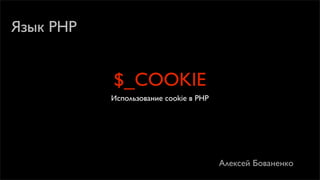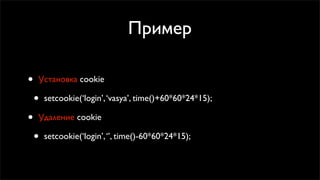cookie. support by php
- 1. –ѓ–Ј—Л–Ї PHP $_COOKIE –Ш—Б–њ–Њ–ї—М–Ј–Њ–≤–∞–љ–Є–µ cookie –≤ PHP –Р–ї–µ–Ї—Б–µ–є –С–Њ–≤–∞–љ–µ–љ–Ї–Њ
- 2. –Т–≤–µ–і–µ–љ–Є–µ вАҐ Cookie –њ–Њ–Ј–≤–Њ–ї—П—О—В —Е—А–∞–љ–Є—В—М –і–∞–љ–љ—Л–µ –љ–∞ —Б—В–Њ—А–Њ–љ–µ –њ–Њ–ї—М–Ј–Њ–≤–∞—В–µ–ї—П
- 3. –£—Б—В–∞–љ–Њ–≤–Ї–∞ cookie вАҐ bool setcookie ( string $name [, string $value [, int $expire [, string $path [, string $domain [, bool $secure [, bool $httponly ]]]]]] )
- 4. –Я—А–Є–Љ–µ—А вАҐ –£—Б—В–∞–љ–Њ–≤–Ї–∞ cookie вАҐ setcookie(вАШloginвАЩ, вАШvasyaвАЩ, time()+60*60*24*15); вАҐ –£–і–∞–ї–µ–љ–Є–µ cookie вАҐ setcookie(вАШloginвАЩ, вАШвАЩ, time()-60*60*24*15);
- 5. –Я–Њ–ї—Г—З–µ–љ–Є–µ –і–∞–љ–љ—Л—Е –Є–Ј cookie вАҐ $_COOKIE[вАШvalue_nameвАЩ]
- 6. –Ъ–Њ–љ–µ—Ж –°–њ–∞—Б–Є–±–Њ –Ј–∞ –≤–љ–Є–Љ–∞–љ–Є–µ e-mail: a.bovanenko@gmail.com


![–£—Б—В–∞–љ–Њ–≤–Ї–∞ cookie
вАҐ bool setcookie ( string $name [, string $value [, int
$expire [, string $path [, string $domain [, bool
$secure [, bool $httponly ]]]]]] )](https://image.slidesharecdn.com/phpcookies-091216150936-phpapp01/85/cookie-support-by-php-3-320.jpg)

![–Я–Њ–ї—Г—З–µ–љ–Є–µ –і–∞–љ–љ—Л—Е –Є–Ј cookie
вАҐ $_COOKIE[вАШvalue_nameвАЩ]](https://image.slidesharecdn.com/phpcookies-091216150936-phpapp01/85/cookie-support-by-php-5-320.jpg)
